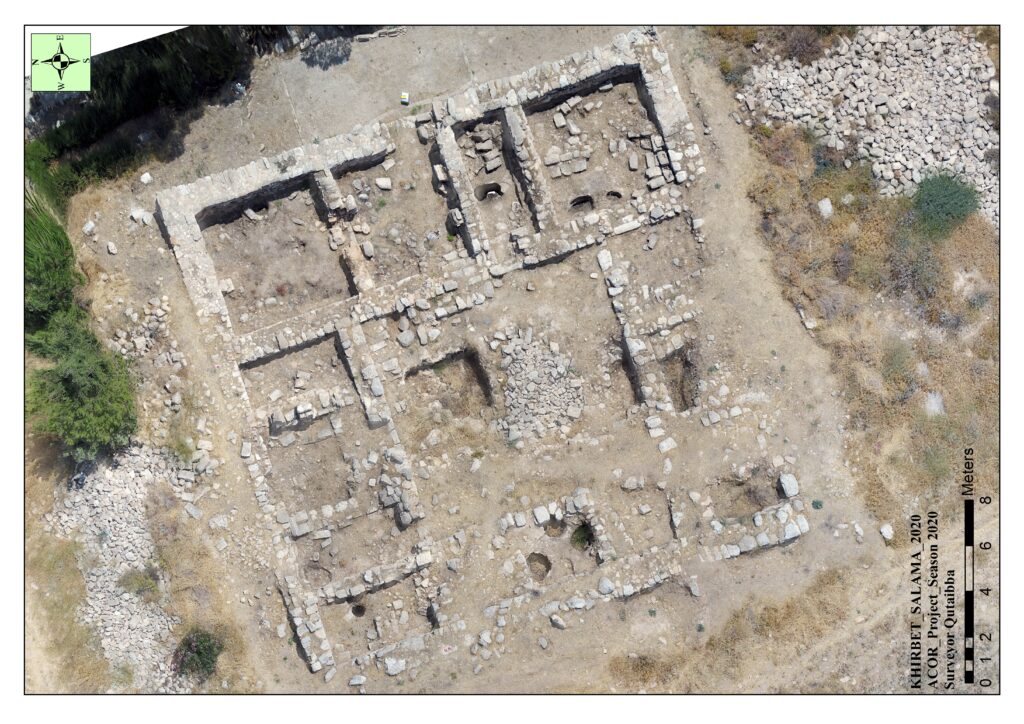Located next to the American Center of Research in Tla’ al-Ali, Amman, the site was first surveyed in the 1970s by Mujahed Muheisin of Yarmouk University and was partially excavated in the 1980s by Cherie Lenzen and Allison McQuitty on behalf of the American Center. In the early 1990s, ACOR Director Pierre M. Bikai carried out further excavations. At that time, the site became a field school for the training of students at the University of Jordan.
Overlooking a fertile valley in antiquity, the site known as Khirbet Salameh was an agricultural settlement founded in at least the 3rd century BC, during the Hellenistic period. The current building is a unique example of preserved rural architecture in the Amman area, dating to the Roman period, from the 2nd century AD and still functioning or reused during the Byzantine and early Islamic periods. The site was partially excavated and documented in the 1970s and 1980s, then utilized in the 1990s as a field school site with the University of Jordan, by Pierre Bikai [1], director emeritus of ACOR. The fortified square main structure is primarily built of limestone, measuring 24 by 24 meters. The main gate faces east, where the water and fertile agricultural lands were most accessible. The building includes 14 rooms around an inner courtyard. The site adjoins the American Center’s property.
I. Hellenistic coin (Ptolemy ll?, possibly from Tyre) found in the survey around Khirbet Salameh (published in Bikai 1993, Pl.II.1)
Cultural heritage valorization efforts stressed site protection in advance of any site presentation. Based on this approach, basic protection efforts were undertaken in 2020,[2] with further more comprehensive works at Khirbet Salameh started in January 2021.[3] All efforts were in collaboration and by joint agreement with the Department of Antiquities. The first phase consisted site cleaning, buttressing fragile areas, covering deep holes, and recording/visualizing the site in its current condition, led by Jack Green. The second phase included building a stone wall along the eastern exposed cliff side to protect it from any geological instability, in addition to build-up a proper stair case with handrails to protect visitors, a joint effort overseen by Ala’a Al Badarin and Jehad Haron, and supported by the USAID-funded Sustainable Cultural Heritage Through Engagement of Local Communities Project (SCHEP). The third stage focused on urgent and minimal intervention inside the archeological site, to further stabilize the open holes and install metal covers on the wells and the pit silos, in addition to adding a lightning system. Protecting the landscape was part of the third phase through the planting of trees around the perimeter, in line with the standards of demarking and preserving the archaeological site from potential encroachment.
The re-presentation and interpretation for this micro-site is an exciting opportunity within urban Amman, an area under daily development that presents a threat to such historic agricultural settlements in urban spaces. Accordingly, in late 2021 and early 2022 augmented reality and virtual tours were created, by Hussam Ababneh, to allow different societal groups to interact with the site and better understand the historical content of the site. The augmented reality app usable at the site can now be downloaded from the Google Play store or Apple App store.
For more details, see:
Lenzen, C. J. and A. McQuitty. 1984. Khirbet Salameh. Annual of the Department of Antiquities of Jordan 28: 295.
Lenzen, C. J. and A. McQuitty. 1987. The Site of Khirbet Salameh. Annual of the Department of Antiquities of Jordan 31: 201–4.
Bikai, P. M. 1993. “Khirbet Salameh 1992.” Annual of the Department of Antiquities of Jordan 37: 521–29, pls. I–II.
Bikai, P. M. 1993. “Khirbet Salameh,” in B. de Vries and P.M. Bikai (eds.) “Archaeology in Jordan.” American Journal of Archaeology 97 (3): 503–4.
Walker, S. C. 2004. “Khirbet Salameh: An Archaeological Analysis of a Late Roman/Byzantine Farm Complex.” Unpublished M.A. thesis, University of Leicester.











